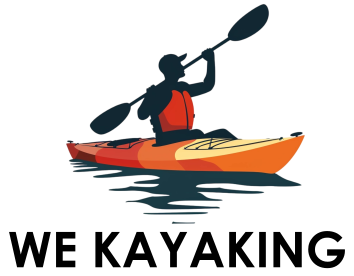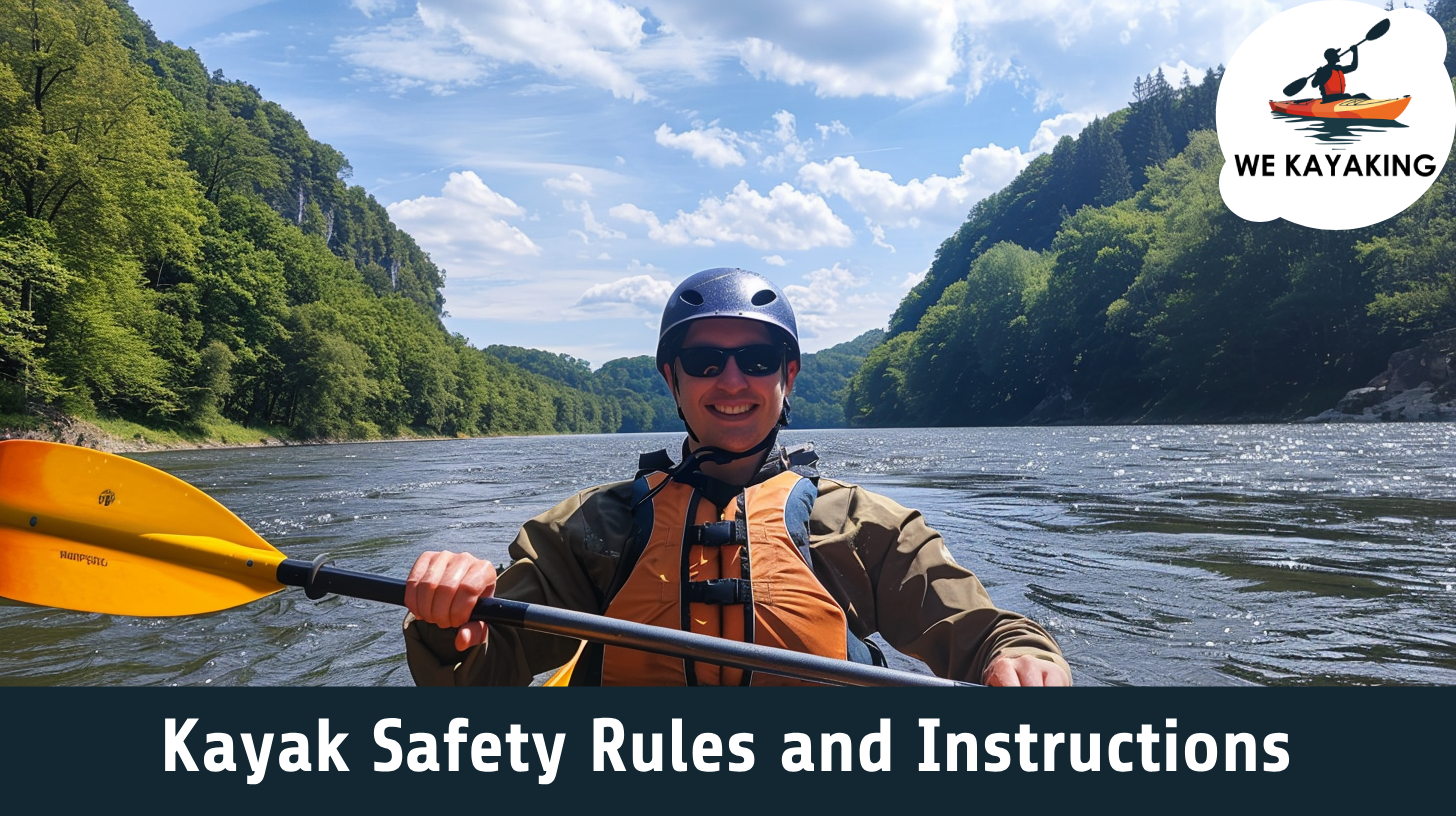
Kayak Safety Rules and Instructions
Kayak safety refers to the guidelines and practices that ensure the well-being of kayakers. Key points include wearing bright colors or a high-visibility life jacket, understanding the weather and water conditions, knowing self-rescue techniques, using appropriate gear, having proper training or experience, and understanding how to navigate and handle the kayak.
Additionally, kayakers should plan their route, inform someone of their plan, stay hydrated and protected from the elements. They should always check the condition of their equipment, plan an alternative take-out point in case of emergency, monitor the weather, and dress appropriately for the weather. Understanding navigational rules and signaling techniques, as well as being aware of other watercraft, are vital for avoiding collisions.
Table of Contents
What determines the safety of a kayak?
The safety of a kayak is determined by its design, stability, buoyancy, and appropriateness for the intended conditions. The kayak’s overall stability and handling are influenced by various factors, including its length, width, and hull shape.
Safety significantly affects the choice of a kayak as it determines the suitability of the kayak for the paddler’s skill level, the intended use, and the conditions they will face. Safety features, such as comfortable seating, accessible storage, and attachment points for safety gear, are also important considerations. When choosing a kayak, it’s crucial to consider these aspects in relation to your skill level, size, and the type of paddling you will be doing to ensure a safe and suitable match.
Furthermore, personal fit is a key safety aspect. A kayak that is too big or too small for the paddler is difficult to control and uncomfortable, potentially leading to unsafe situations. Therefore, a kayak’s size and cockpit dimensions should be appropriate for the paddler’s body size and ability to comfortably reach and operate the controls.
What type of kayak is the safest?
The recreational kayak is considered the safest type of kayak. The safety offered by a recreational kayak is a significant factor, especially if you’re new to the sport or if you prefer leisurely paddling in safe, calm waters. Its user-friendly design, ease of entry and exit, and overall stability make it a reliable choice.
Its wide hull offers greater stability, which is particularly reassuring for beginners or casual paddlers. This stability reduces the risk of capsizing, making it a popular choice for calm waters, like lakes and slow-moving rivers.
Are larger kayaks safer?
Yes, larger kayak sizes are considered safer. Their increased size provides more stability and buoyancy, reducing the risk of capsizing. This stability is reassuring and allows for a more relaxed experience.
Larger kayak sizes, with their increased length and width, offer enhanced primary stability (stability when the kayak is upright) and secondary stability (stability when the kayak is tilted). This makes them less likely to tip over in calm waters, which is particularly beneficial for beginners or casual paddlers who have not developed advanced balancing skills.
Are safe kayaks expensive?
No, safe kayaks are not expensive. The cost of a kayak depends on factors like the material, design, brand, and additional features rather than safety alone. Kayaks under $500 are safe for calm, sheltered waters and stable enough for most use cases. These kayaks are wider, providing good primary stability.
Mid-range kayaks, priced between $500 and $1000, offer improved safety features, such as better construction and enhanced secondary stability, and are suitable for a variety of conditions including mild open water kayaking.
High-end kayaks, exceeding $1000, are designed with specialized safety features for specific environments like rough sea waters or rapid rivers. They often have advanced designs for better handling and stability in these conditions.
How to stay safe on a kayak?
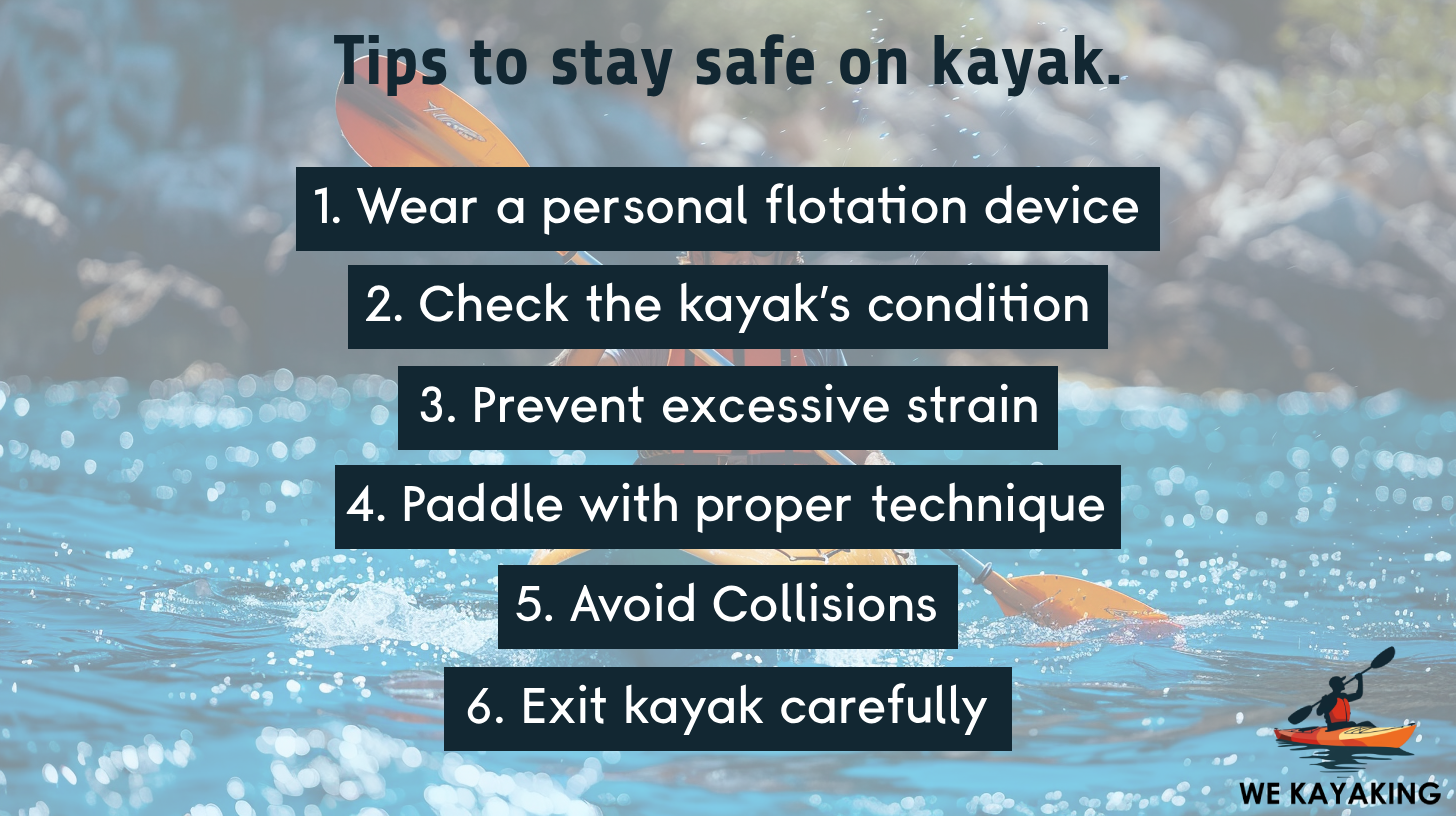 To stay safe on a kayak, it involves a combination of preparation, awareness, and proper equipment. The 6 safety tips for kayakers are listed below.
To stay safe on a kayak, it involves a combination of preparation, awareness, and proper equipment. The 6 safety tips for kayakers are listed below.
- Wear a personal flotation device
- Check the kayak’s condition
- Prevent excessive strain
- Paddle with proper technique
- Avoid Collisions
- Exit kayak carefully
1. Wear a personal flotation device
Wearing a personal flotation device (PFD) is a critical safety measure in kayaking. It provides essential buoyancy support, keeping you afloat in case you capsize or fall out of the kayak. This is especially important if you’re unable to swim due to injury, fatigue, or shock. Kayakers should use PFDs designed for paddling, which offer comfort and allow for a full range of motion, often featuring pockets and tabs for gear. A PFD also offers an extra layer of insulation in cold water, helping to reduce the risk of hypothermia.
2. Check the kayak condition
Checking the condition of your kayak before each use is a vital safety step. Start by inspecting the hull for any signs of damage like cracks, dents, or deep scratches, as these lead to water leakage or failure during use. It’s also important to check the bungee cords and straps, as they secure gear during your trip, and worn or frayed cords will lead to losing equipment or an unbalanced kayak. If your kayak has bulkheads and hatches, verify their watertight integrity since they are essential for buoyancy and stability.
The seats and foot pegs should be securely attached and in good condition, as they are critical for comfortable and effective paddling. Lastly, ensure all safety equipment, including bilge pumps and emergency gear, is present and functional.
3. Prevent excessive strain
Preventing excessive strain while kayaking is crucial for safety as it helps avoid physical injuries and fatigue. Paddling for extended periods, especially without proper technique, leads to muscle strains, joint pain, or even more serious injuries. Fatigue reduces your ability to react swiftly and make sound decisions, increasing the risk of accidents. It’s important to maintain a proper paddling technique, use ergonomic equipment, take regular breaks, and stay hydrated to minimize strain.
4. Paddle with proper technique
Paddling with proper technique is crucial for safety as it enhances control over the kayak and prevents physical injuries. Good technique involves using your core muscles, rather than just your arms, for efficient and powerful strokes. This reduces the risk of arm and shoulder fatigue or strain. Proper technique also ensures better maneuverability and stability of the kayak, allowing you to respond effectively to changing water conditions.
5. Avoid collisions
Avoiding collisions is a key safety aspect in kayaking. It involves being constantly aware of your surroundings, including other watercraft, obstacles, and environmental conditions. Practicing good situational awareness helps you anticipate and avoid potential hazards. Knowing navigational rules, such as who has the right of way, and using proper signaling methods to communicate with other water users are essential. Maintaining a safe distance from large vessels, which have limited maneuverability and visibility, is also crucial.
6. Exit kayak carefully
Exiting a kayak carefully is important for safety to avoid capsizing and personal injury. When exiting, keep your weight centered and low to maintain balance. Use your hands to steady yourself on the dock or shore, and swing your legs out of the cockpit before standing up. Exiting carefully is especially important in unstable or slippery conditions to prevent falls.
Do you need to pass a safety test before going kayaking?
No, you do not need to pass a safety test before going kayaking. However, it is highly recommended to have basic knowledge of kayaking safety, techniques, and water rules, especially for beginners or when paddling in unfamiliar or challenging environments. Some regions or rental services require a brief safety orientation or proof of competency for certain types of kayaking, like sea or whitewater kayaking. It’s always a good idea to be informed and prepared for your safety and the safety of others on the water.
Is it safe to use a kayak without a vest?
No, it is not safe to use a kayak without wearing a vest. A vest is a crucial safety item that significantly increases your chances of survival in case of capsizing or falling into the water. It provides buoyancy to keep you afloat, which is vital if you are injured, fatigued, or in cold water where the risk of hypothermia is high.
Is it safe to use a kayak without a helmet?
Yes, it is safe to use a kayak without a helmet in calm, flat water environments like lakes or slow-moving rivers. However, in more hazardous conditions, such as whitewater kayaking, rocky areas, or fast-moving rivers, wearing a helmet is crucial for safety. A helmet protects your head from injuries due to collisions with rocks, debris, or other hard surfaces.
Is it safe to use a kayak if you don’t know how to swim?
No, it is not safe to use a kayak if you don’t know how to swim. In the event of capsizing or falling out of the kayak, being able to swim increases your chances of safely recovering or reaching safety. Non-swimmers are at a higher risk in such situations, even with a life jacket.
Is it dangerous to go kayaking during winter?
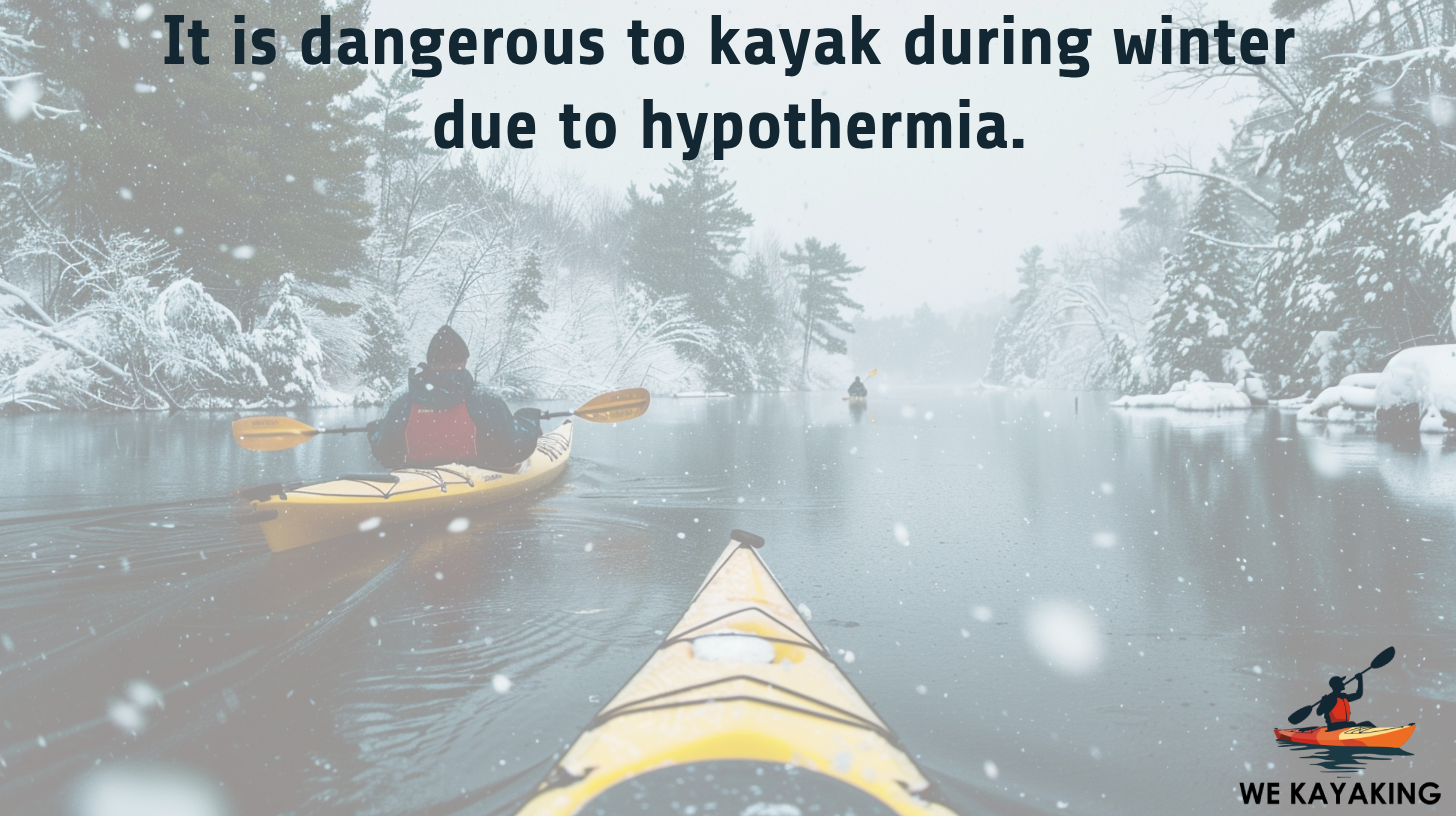 Yes, kayaking during winter is dangerous due to the increased risks posed by cold water and cold weather conditions. Cold water increases the risk of hypothermia if you capsize or get wet. Winter weather is also unpredictable, with the potential for sudden changes that creates hazardous conditions. Fewer people are also likely to be around to help in case of an emergency.
Yes, kayaking during winter is dangerous due to the increased risks posed by cold water and cold weather conditions. Cold water increases the risk of hypothermia if you capsize or get wet. Winter weather is also unpredictable, with the potential for sudden changes that creates hazardous conditions. Fewer people are also likely to be around to help in case of an emergency.
Is it dangerous to go kayaking during strong wind?
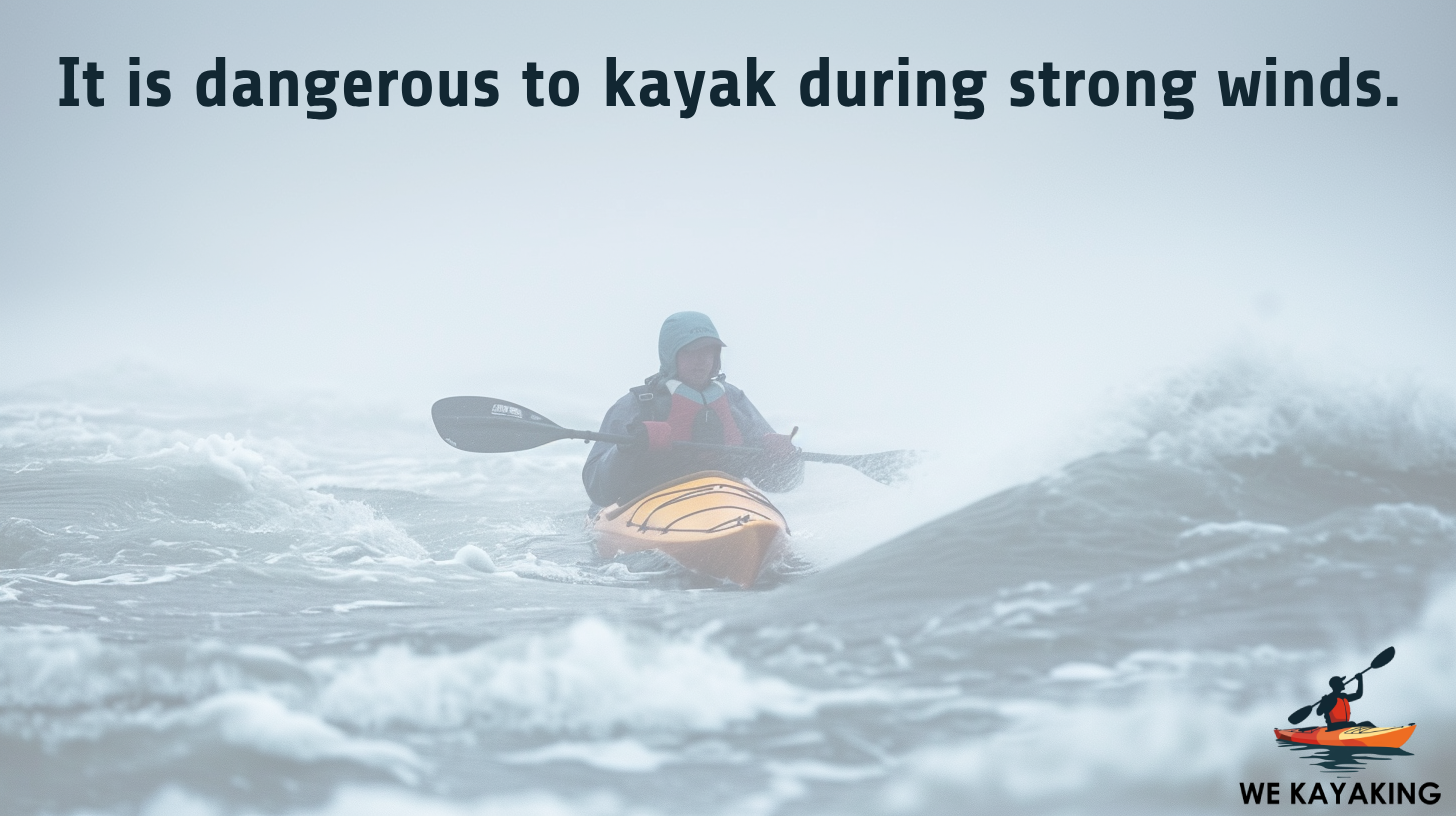 Yes, kayaking in strong wind is dangerous. Strong winds create challenging conditions on the water, making the kayak difficult to control and increasing the risk of capsizing. Wind also leads to larger waves and rougher water, which requires more skill to navigate safely. Additionally, strong winds will quickly blow you off course or make it very tiring to paddle back to shore.
Yes, kayaking in strong wind is dangerous. Strong winds create challenging conditions on the water, making the kayak difficult to control and increasing the risk of capsizing. Wind also leads to larger waves and rougher water, which requires more skill to navigate safely. Additionally, strong winds will quickly blow you off course or make it very tiring to paddle back to shore.
Is it dangerous to go kayaking in the river with rocks?
Yes, kayaking in a river with rocks is dangerous. Rocks create obstacles that cause the kayak to tip or get stuck, and collisions lead to injuries or damage to the kayak. Navigating rocky rivers requires skill in steering and maneuvering, as well as the ability to read the river’s current and anticipate how it interacts with the rocks.
Is it dangerous to go kayaking in the sea?
Yes, kayaking in the sea is dangerous due to factors like changing tides, strong currents, large waves, and unpredictable weather conditions. Sea kayaking requires specific skills and knowledge, such as understanding tides and weather patterns, navigating, and self-rescue techniques. The open sea is challenging due to its vastness and rapid changes in conditions.
Is it dangerous to go kayaking in the ocean?
Yes, kayaking in the ocean is dangerous due to factors like strong currents, tides, large waves, and exposure to rapidly changing weather conditions. The vastness of the ocean also means that help could be far away in case of an emergency. Ocean kayakers must be skilled in navigation, understanding weather patterns, and handling their kayak in rough water.
Is it dangerous to kayak in a tandem?
No, kayaking in a tandem kayak is not dangerous; it is equally as safe as kayaking in a single kayak, provided both paddlers understand and practice safe kayaking techniques. Tandem kayaks require good communication and coordination between the paddlers to effectively navigate and control the kayak. It’s important that at least one of the paddlers has sufficient experience and knowledge of paddling and safety techniques. Tandem kayaks are beneficial for beginners paired with more experienced kayakers.
What to do if you got lost while kayaking?
If you find yourself lost while kayaking, first stay calm and use a map and compass to navigate back to your launch point. As you paddle, it’s important to pay attention to the landmarks around you and take note of any distinctive features, like islands, rocks, or buoys. These serve as reference points to help you orient yourself.
If you’re unsure of your location, use these landmarks in conjunction with your map and compass to determine your position and plot a course back. Additionally, if you have a GPS device or a phone with a GPS app, it is an invaluable tool in helping you find your way. Remember, staying calm and thinking clearly is crucial in such situations.
What to do if you lose your paddle while kayaking?
If you lose your paddle while kayaking, immediately secure your kayak to prevent drifting further. Use your hands to paddle to the nearest shore or stable area. Once ashore, search the nearby water for the paddle. If you’re with others, signal for assistance. If the paddle is irretrievable and you’re alone, use any available item in the kayak, like a spare oar or board, to paddle. If no alternative is available, stay with your kayak, as it’s your main flotation device, and signal for help or wait for rescue. Always carry a whistle or emergency signaling device for such situations.
What to do if you got injured while kayaking?
If you get injured while kayaking, follow these treatment options.
Rest reduces the use of the injured body part, particularly if it’s a wrist or elbow injury, to aid in healing.
Put a whole ice pack on the injured area and apply it for 15-20 minutes per day, dividing this time into short intervals.
While on a kayak, use compression bandages correctly to help decrease initial swelling.
If possible, elevate the injured limb to reduce swelling.
Seek medical help if the injury is severe or does not improve, and seek medical attention as soon as possible.
Carefully navigate back to shore or signal for help if the injury impedes your ability to kayak.
Stay calm and assess the injury to determine the next steps.
What to do if your kayak got damaged during kayaking?
If your kayak gets damaged while kayaking, follow these steps for repair.
Determine the location and extent of the damage as soon as possible, but with caution.
Use any waterproof material that is available, or apply a temporary patch.
Head for the closest stable area or shore.
Remove any loose or broken material from the damaged area.
Cut suitable reinforcement material for the repair patches.
Mix the epoxy repair resin with the hardener thoroughly.
Apply a coat of this mixed epoxy resin to the damaged area.
Place the reinforcement material over it and ensure it’s fully saturated with resin.
Cover the repair with stretch release film for a smooth finish.
How to prevent a kayak from tipping over?
To prevent your kayak from tipping over, start by balancing your weight evenly in the center of the kayak. Make sure to keep your movements slow and deliberate to avoid sudden shifts. It helps to lower your center of gravity by sitting or kneeling down, which adds to the stability. Also, ensure that any gear you have is distributed evenly throughout the kayak to maintain balance.
Practice bracing techniques which help you counterbalance any unexpected shifts in weight or direction. Be cautious not to overreach or lean too far over the sides of the kayak, as this easily leads to capsizing. Utilize paddle strokes that enhance stability, like low-angle paddling, and always stay aware of the water conditions around you, adjusting your posture and paddling technique as necessary to suit the environment.
How to safely get in the kayak if it capsized?
If your kayak has capsized, here’s how to safely get back in:
- Slowly pull the kayak towards your body. As you do this, roll or flip the kayak right-side up while you are still in the water.
- To re-enter the kayak, position yourself alongside it, right in the middle. This is the most stable point.
- Then, boost yourself up and over the side of the kayak, aiming to get your body lying across the seat.
- Once you are lying across the kayak, slowly move your legs into the cockpit one at a time, keeping your weight centered.
- Gradually shift your body into the sitting position, being careful to maintain balance.
- Re-adjust your seating position, ensuring you’re properly positioned and comfortable.
- Secure your spray skirt if you have one, and check that all your gear is in place and secured.
- Use your paddle to stabilize the kayak as you settle back in.
How to get into a kayak if it tipped over is a common question among beginner kayakers and experts alike. It emphasizes the steps sought in case of an emergency of the kayak capsizing. Every kayaker should follow these steps in case of such a scenario.
